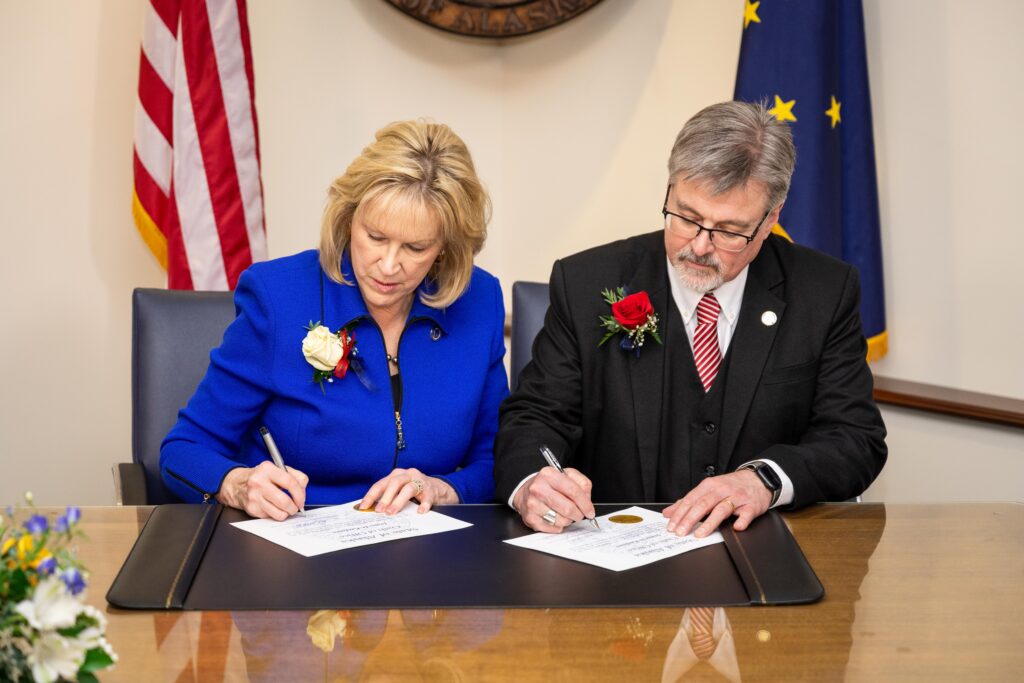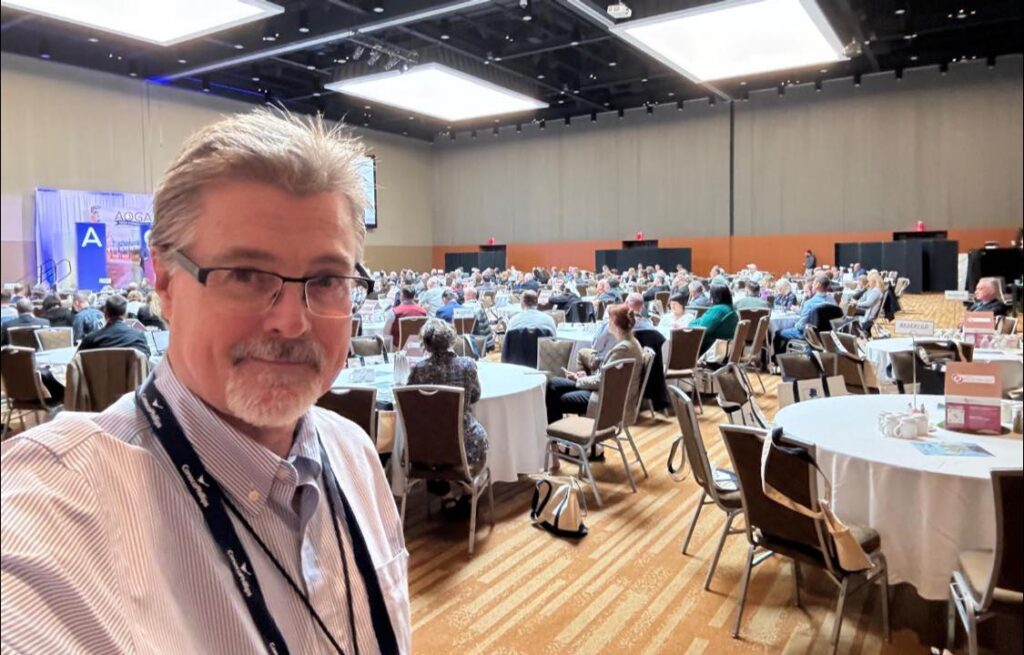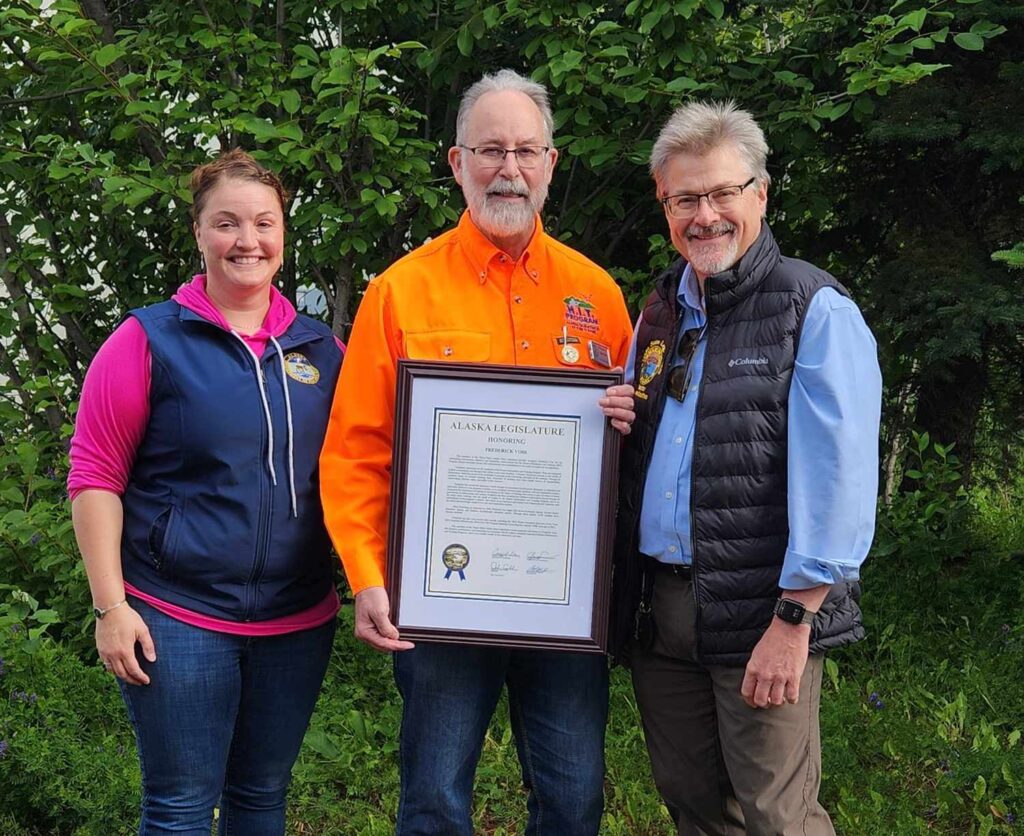We are officially at mid-point in the first legislative session of the 34th legislature, and there’s lots of movement, a fair bit of smoke, some heat, and occasional glimpses of light. Let me explain…
Movement: Bills are being presented and heard, the budgets are being assembled, and all this action is projected against the backdrop of a very tight budgeting year. Despite the fact we are facing serious revenue constraints this year due to a near term dip in revenues, there are many competing, very robust proposals to increase spending on nearly all fronts.
Smoke: At the time of this writing, the spending proposals in the Governor’s Budget and House Finance Committee’s budget include deficit spending ranging from $1.5 billion to close to $2 BILLION respectively! There’s no way to fund numbers like this without draining our savings in the Constitutional Budget Reserve (CBR) or pulling more than the 5% market value out of the Permanent Fund.
I mentioned heat, and that is present in the form of the many advocates petitioning the legislature for every possible form of spending. Whatever the worthy cause, they are visiting our office, sending emails, calling, and sometimes demonstrating vigorously on the capitol steps. There are always eager advocates for projects and many programs that affect every part of our state.
Now for a little light:
The budgets for the past 5+ years have essentially flat-funded most departments and their programs with two notable exceptions: the departments of Public Safety and Corrections which have seen an inflation adjusted growth of 37% and 23% respectively since 2016.
When adjusted for inflation, every other department in the executive branch has seen their budget shrink or (in the case of two) grow less than 10% since 2016 (see the full chart here). This has resulted in a “coiled spring” effect, where the many needs are piling up and becoming more visible.
Unfortunately, all of this is occurring at a time when the price of oil is relatively low and the new oil and gas projects have not yet come online, resulting in a near-term dip in resource revenues. There’s little to no chance of increased revenues for the 2026 budget, so something has got to give.
What will unavoidably have to happen as the session continues is that some spending proposals will get sidelined or trimmed to fit within the allowable margins of existing revenue streams. We have prospects for increased future revenue to the state with these new projects, but there is no foreseeable way for the various “revenue enhancements” (new or increased taxes) to be enacted quickly enough to affect the budget we are now creating for Fiscal Year 2026.
This will be tough news for those who have promised constituents overly generous increased spending, because there is only so much to go around in the current budget cycle.
The good news is that the incredible work being done to sustain and increase production on the North Slope will result in a greatly improved revenue potential, but we just need to carefully manage through the next few lean years.
What is critical, in my opinion, is that we fund essential programs as well as we can, while avoiding the traps of digging too deeply into savings or creating new or expanded taxes that somehow negatively impact the potential for increased private sector investment in Alaska.
I strongly believe that private sector activity will be increasing in our state, if we allow it, because of pro-development policies that are now coming out of the new administration in Washington DC. In this time of change, what is essential is that we all work together, both in Juneau and in Washington DC to grasp the current reality of emerging resource development and other opportunities.
The winds of change brings challenges, but I believe that we can successfully navigate them if we pull together and collectively focus upon what is best for Alaska’s future as a proud and independent state with a growing private sector economy.
I’ll unpack some of these thoughts in greater detail down below, so please keep reading and as always, please share your thoughts if you have questions or comments.
The Budget Picture
For the last few weeks, the Finance Committee has been drilling down into the budget and trying to come up with a plan that is balanced. Our constitution requires that the budget be balanced before it can be signed into law by the Governor.
This will be no easy task, and some tough decisions will need to be made. I will do my best to lay out the current landscape of where we are at.
The state budget for the upcoming year is known as Fiscal Year 2026, or FY26, but while we work on that, there are deficits in last year’s budget, FY25, that must be filled first. We do our best to try and predict spending and revenues in the following year, but we don’t always hit our mark and any deficits from the previous year must be filled first.
The current deficit for the FY25 budget sits at $164.7 million. Much of that is due to oil prices declining more than anticipated throughout last year (when we passed the budget last year, we anticipated a $150 million surplus). We also needed more money to pay for disaster relief for after several large storms and other disasters happened around the state.
The Governor’s proposed FY26 budget (introduced in December) has a $1.65 billion deficit. The legislature typically uses the governor’s proposed budget as a baseline and then works from there. The legislature must now figure out how to balance the Governor’s proposed budget while also filling last year’s deficit.
There are a few things to note about the Governor’s current budget that will almost certainly be changed by the time we are finished.
For one, the Governor’s budget includes a roughly $3700 PFD at a total cost of a little over $2.4 billion. For the last two years, the PFD has been determined using a formula we call the 25/75 of the POMV. I’ve discussed it before, so I won’t go too much into it again, but in last year’s budget we appropriated just under $1 billion for the PFD using that formula.
Something that was not included in the governor’s FY26 budget was any sort of increase to the BSA. Last year’s budget included one-time funding at the equivalent of an additional $680 to the BSA at a total cost of around $175 million to the state. I believe that this year’s budget will include at least that same amount—I will talk about more about the education debate in the next section of this newsletter.
That means if we use the same PFD formula and BSA increase as last year, and with NO other changes then this year’s budget still doesn’t pencil out—we are still are looking at a deficit of $300 million. Don’t forget the $165 million deficit for FY25. That’s a $465 million gap that must be filled by something when we pass the budget this year. And that’s not including needed funding for other programs that will almost certainly make it into the budget.
Not to sound too much like a broken record, but I think it’s important to repeat it again: This year’s budget is tight, and we are starting out with unsustainable proposals.
There are some ideas floating around the capitol to fill that gap.
Some are suggesting increasing taxes on oil companies. However, if the legislature were to pass a new tax or other form of new revenue, it is unlikely to kick in in time to help this year’s budget. Alternatively, some of suggested dipping into our two savings accounts, the Earnings Reserve of the Permanent Fund (which currently has an uncommitted balance of $3.2 Billion) and the Constitutional Budget Reserve (which has just under $3 Billion in it).
I am extremely hesitant to tap into either of these savings accounts, as both are at the minimum level that the Legislative Finance Division advise we should have as a rainy-day fund. If we were to pull extra money from the Permanent Fund Earnings Reserve to fill our deficit (we are already withdrawing $3.8 billion to cover base spending, we risk our ability to draw from it in future years. Since the Permanent Fund is our main source of revenue, overdrawing it risks a future fiscal crisis much greater than the one we are facing today.
Similarly, I am hesitant to draw from the Constitutional Budget Reserve. This account is our only remaining savings account. Our budget experts warn against spending below the $3 billion and I agree. I do not want to see this account drawn down any further. There are unforeseen events that could be happen and we don’t want to needlessly put our state in a situation where we do not have the money to fund government. What if oil prices come down even further? What if Medicaid funding gets reduced? These are situations where we will want to have that rainy day fund well capitalized.
The Education Bill Lands in the Senate
Education remains a major focus in the Legislature. In this section I will build off of my previous newsletter, which you can read here >> (Note that the date listed in the newsletter says 2024, but it was sent February 12, 2025)
Since my last newsletter, the education debate has been focused on House Bill 69. The House spent the past two weeks making substantial changes to the bill, first in the House Rules committee and finally on the House Floor. The House then narrowly passed the amended bill on Wednesday, March 12th. It is now in the Senate Education Committee, where it was heard every day this week and is scheduled again to be heard on Monday and Wednesday of next week.
Here are a few of the high-level elements of HB 69 passed by the House. In total, this version of the bill equates to a roughly $275 million yearly increase to education funding:
- BSA: A $1,000 increase to the Base Student Allocation. (The current BSA is $5960)
- Open Enrollment: Requires school districts to allow students attend any school within their school district for three years (after which the legislature would need to extend the requirement). The Anchorage School District already has open enrollment policies, so from what I am hearing, this section does not impact the district much.
- Charter Schools: Includes language improving several processes at charter schools including adding a coordinator position on the state level to help new charter school applicants navigate the approval process.
- Academic Performance Accountability: Reforms testing standards to better measure academic performance over time.
- Reads Act: Provides a $450 grant to school districts for each student who meets the reading proficiency standards set in the Reads Act which became law in 2022.
- Cell Phone Use: Requires local school districts to adopt a policy regulating cell phone use during the school day.
- Establishes the Task Force on Education Funding which will submit their findings in January of 2026.
I expect the Senate Education Committee to finish their work on the bill in the next week or two. Once they are done, the bill comes to the Senate Finance Committee on which I serve. I am watching the bill closely and will be working with my colleagues to hammer out a deal that can get the support the bill requires to become law.
As I talked about earlier in this newsletter, the state is facing huge budget deficits that are exacerbated by increased funding proposals. Some of the same budgetary pressures the Anchorage School District is facing are happening elsewhere across the state. Considering this reality, I will be working to ensure our districts receive additional funding they need, and that the increase is sustainable for the long-term. Our schools need stability and predictability so they can retain teachers, students, and the most important classes and programs. It is also important to remember that we must balance our budget within current revenue constraints. As a member of the Senate Finance Committee, I will have to consider all of the state’s needs within the available funds.
The current proposal increases the BSA by $1000. However, nothing is set in stone yet and it is important to manage our expectations. In the Senate Finance Committee, a BSA increase of $680 has been included in some budget proposals as we look at what is affordable. I have no insight on what the final amount will be. Those negotiations will likely happen behind closed doors among House and Senate leadership and the Governor’s office.
At the end of the day, I want to see meaningful improvement in education policy and funding happen this year, and I believe there is the possibility of bipartisan support in the building to do so. That said, the legislative process of pushing HB 69 through the House lacked some of the consensus building efforts that helped pass its predecessor SB 140 with broad support in the prior legislature. The effort now needs to be focused upon crafting something that we can afford, that addresses some of the structural issues with the system that are contributing to Alaska’s low education performance, and that can avoid being stopped in its tracks by a successful veto. Its important to remember that last year’s SB 140 failed by just 1 vote.
Stay involved!
I have heard from many of you about a range of issues our state is facing, including education. I always appreciate your input and take them into account when making these decisions.
I encourage you to stay involved with the Anchorage School Board. While we work on securing funding at the state level, it is important that they hear from folks like you so that the additional funding they receive is spent on the programs and classes that are most important to our parents and students.
Please continue to reach out with your thoughts and opinions. They help inform my decisions greatly!
Learn more in past newsletters:
If you are interested in my perspective throughout the process these past two years, read my newsletters on the subject:
January 29, 2024: Introducing last year’s education debate >>
March 6, 2024: Discussing the education bill (SB 140) after it passed the full Legislature >>
April 22, 2024: Discussing next steps after the Legislature failed to override the veto of SB 140 >>
February 12, 2025: Introducing this year’s education debate and active bills >>
Capital Budget & Projects for our District
Representative Coulombe, Representative Schrage, and I submitted 15 capital projects requests for our district to the capital budget Chair’s office. We worked with folks from the Abbott Loop Community Council, Huffman/O’Malley Community Council, Hillside Community Council, and HALO and our Limited Road Service Areas. Thank you to everyone that helped get those projects submitted.
Unfortunately, due to how tight the budget is, it is highly unlikely our district will get any funding for individual projects this year. In skinny budget years like this, it tends to be that individual capital projects are added to the chopping block first. Nevertheless, by working on these requests this year, it sets up our district to be in a better position to make the same requests in future years.
I am continuing to work with our Chair of the capital budget. If something unexpectedly changes, we are ready with our projects. In the meantime, I have been encouraging our community councils and LRSA’s to work through the municipal process to get on the Muni’s yearly Transportation Improvement Plan.
In the meantime, the projects that we secured funding for last year are moving forward. If you are interested in a more detailed update about any of these, please reach out!
Projects Funded Last Year that are Now in Progress
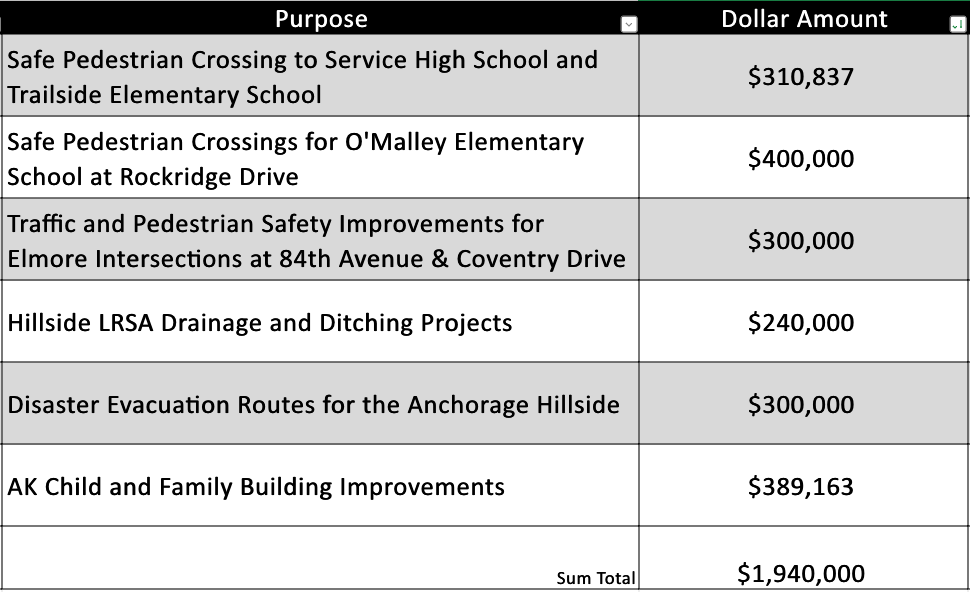
Service High Student Art in the Capitol
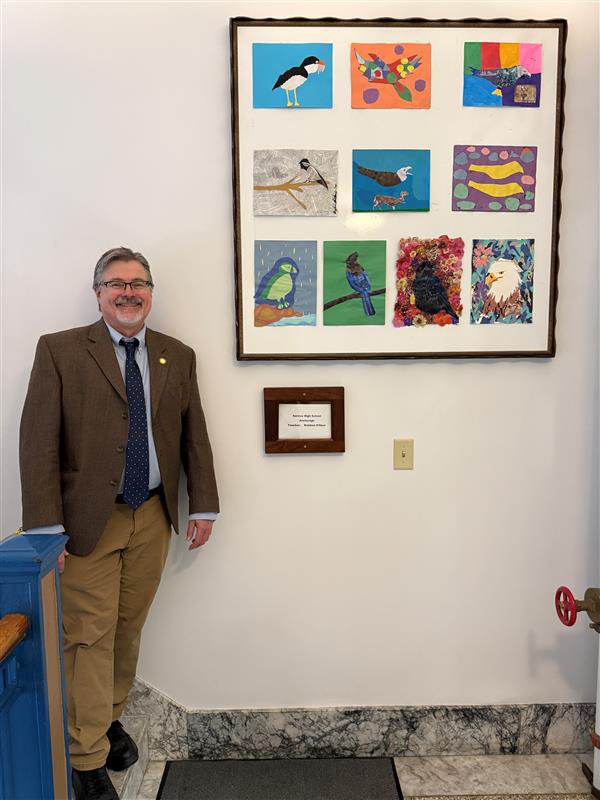
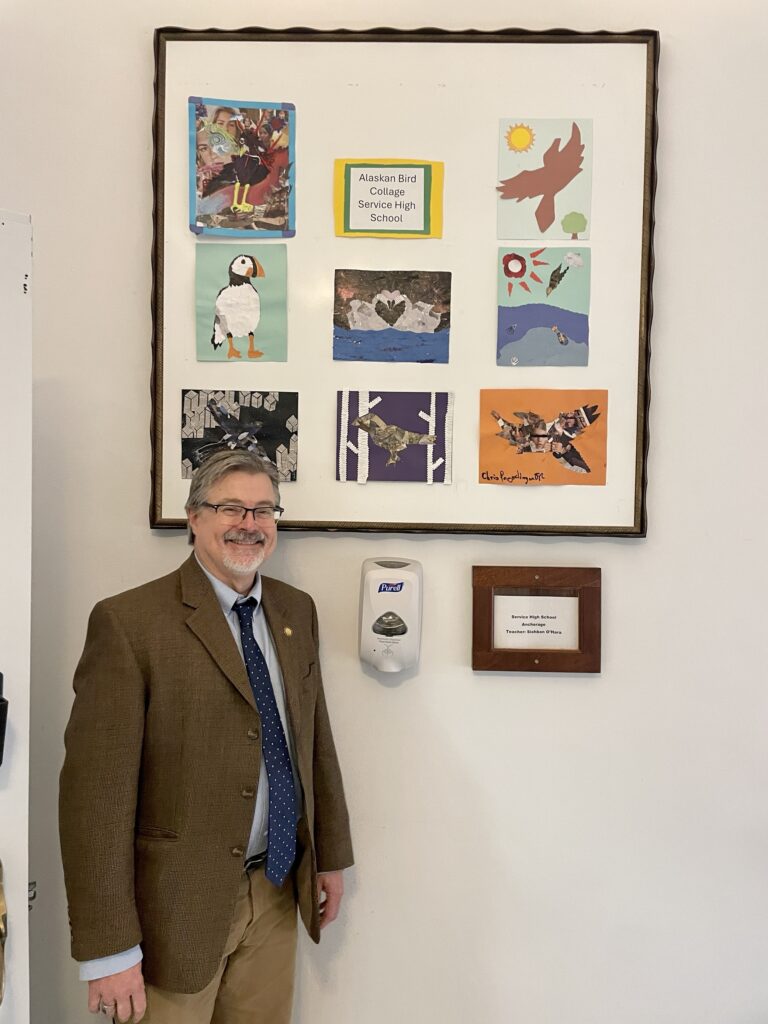
Awesome artwork from Service Highschool is brightening up the Capitol this week! The Alaskan Bird Collage collection was created by the talented students in Ms. Siobhan O’Hara’s art class. Thank you for sharing your creativity with us!
Maelea Joins us in Juneau!
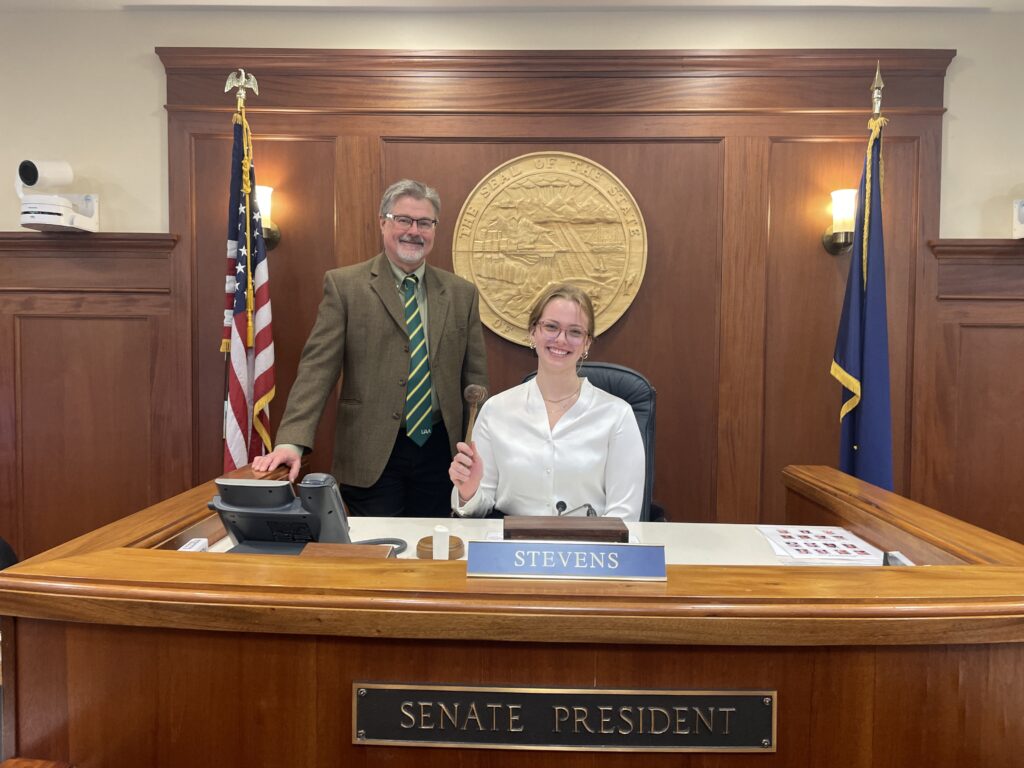
For the last couple of months, I have been mentoring Maelea McFarland, a senior at Bartlett High School, as a part of the Anchorage School District Gifted Mentorship program. Maelea came down to Juneau for the week to get a crash course on how the Legislature works during Session!
She staffed me in Finance Committee Hearings and meetings, helped with office projects, and was a guest page on both the House and Senate Floors. She is particularly interested in journalism and communications, so she helped with Facebook posts, worked with me to respond to emails I’d received, and drafted a press release for one of my bills that we can use later on this session.
Working with these talented young people has been a highlight of my time in the legislature. Maelea is an extremely bright soon-to-be-professional and I am looking forward to seeing what great things she does in her future!
I want to thank Shannon Donley, the Gifted Mentorship Coordinator, for devoting her time to supporting our students as they explore their career interests. And a very special thank you to Jayne McFarland, Maelea’s mom, for making the trip to Juneau so that Maelea could join us for the week.
The Gifted Mentorship Program connects high achieving highschoolers with professionals in different fields who can give them some hands-on experience in a profession of there interest before they graduate. If this sounds like something your student might be interested, learn more here >>
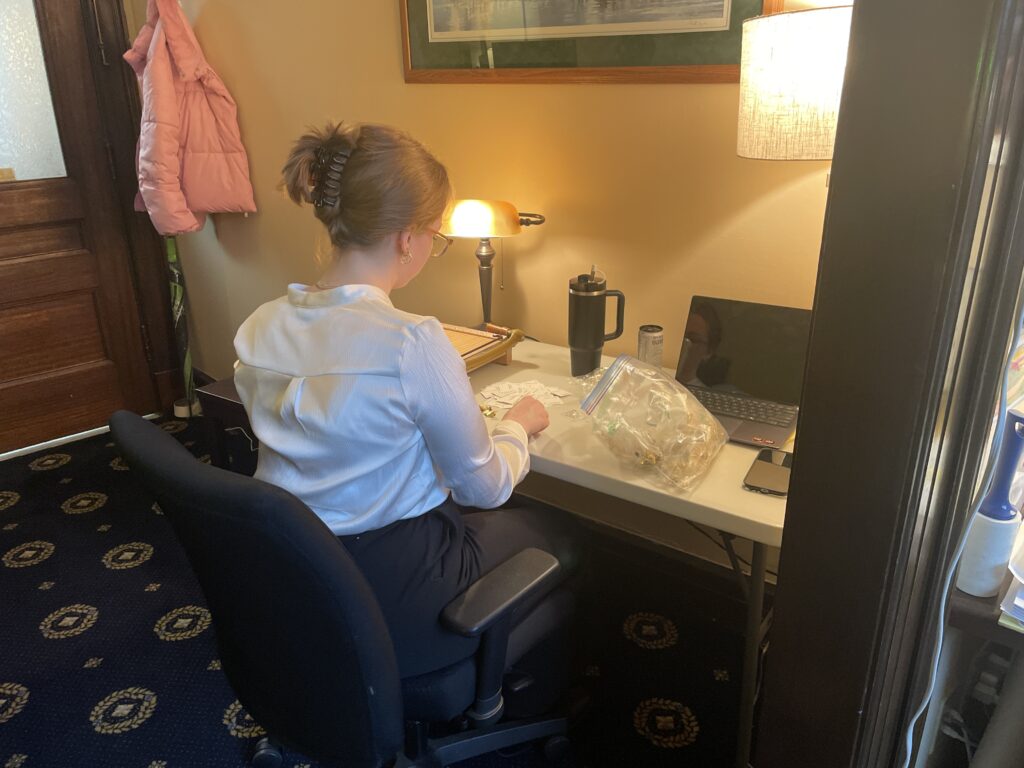
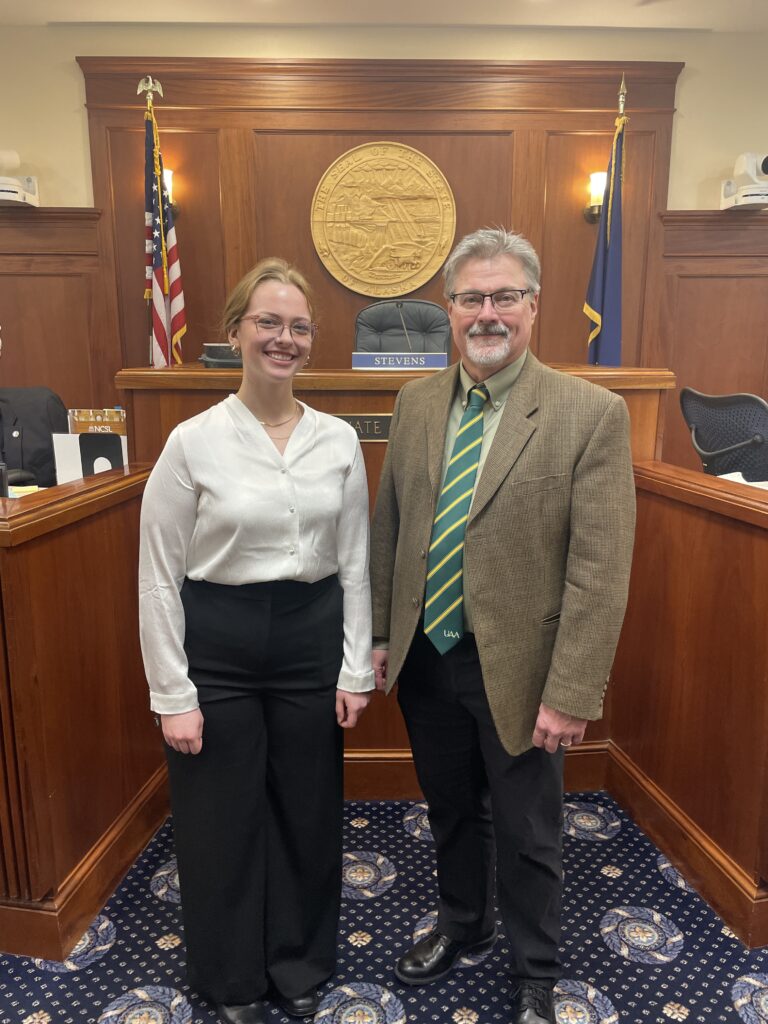
Alaska’s Infrastructure Report Card
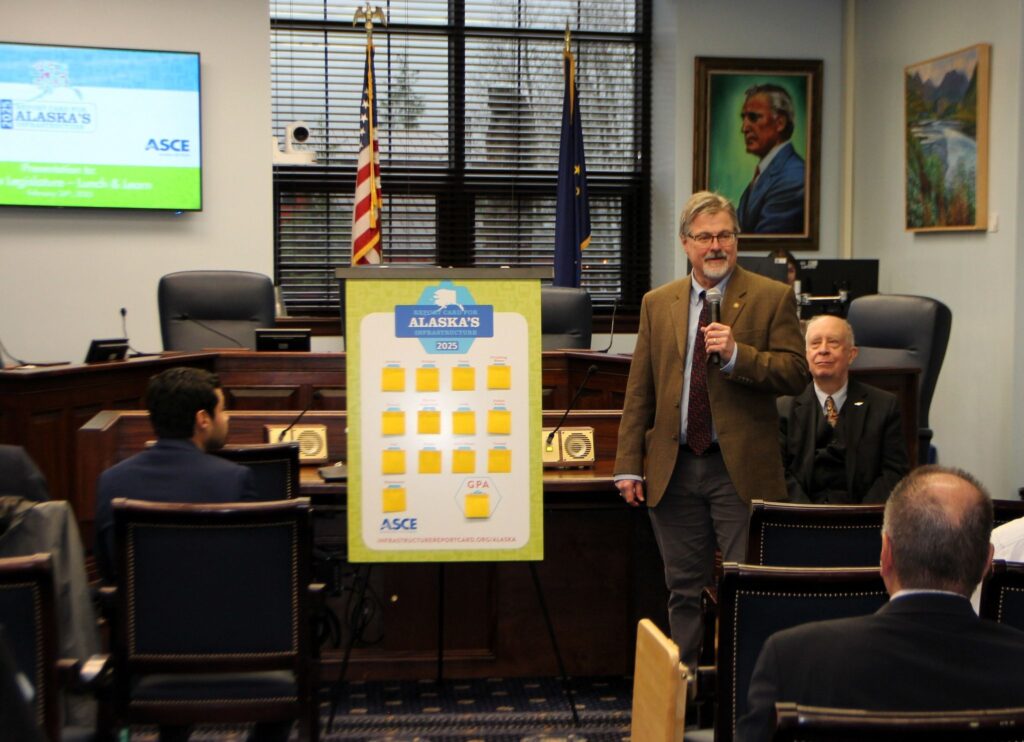
If you use anything more than just air in a day, then you can thank infrastructure for helping provide you with it! Earlier this month, I was excited to host a Lunch and Learn on the 2025 Report Card for Alaska’s Infrastructure. The good news is that our overall grade improved to a ‘C’ since the last report in 2021. However, there’s a lot more that needs to be done.
Thank you to the American Society of Civil Engineer’s and the Alaska Professional Design Council for their countless hours of work they put into publishing this comprehensive report. Take a look at their report here >>
Catch Up on My Bills!
Since I joined the Legislature in 2021, my team and I successfully passed 10 common-sense bills. They addressed government efficiency, workforce development, affordable housing, data security, an all-of-the-above approach to energy, and ensuring Alaskans have responsible access to our incredible lands. If you want to learn more about each of them, you can read about them here, here, and here.
This session, I am focusing my attention on the Finance Committee and preparation of the state’s budget. However, I am once again putting forward and advocating for each element of a broader fiscal plan for the state of Alaska.
The Executive Budget Act | SB 37
Senate Bill 37 reorganizes the Executive Budget Act to integrate strategic planning and performance management into the state’s budgeting process. This legislation would put state agencies on four year strategic operating plans, help the Legislature more effectively review budgets for each agency, and improve transparency for the public. I presented SB 37 to the Senate State Affairs Committee on Tuesday. You can watch the hearing here >>
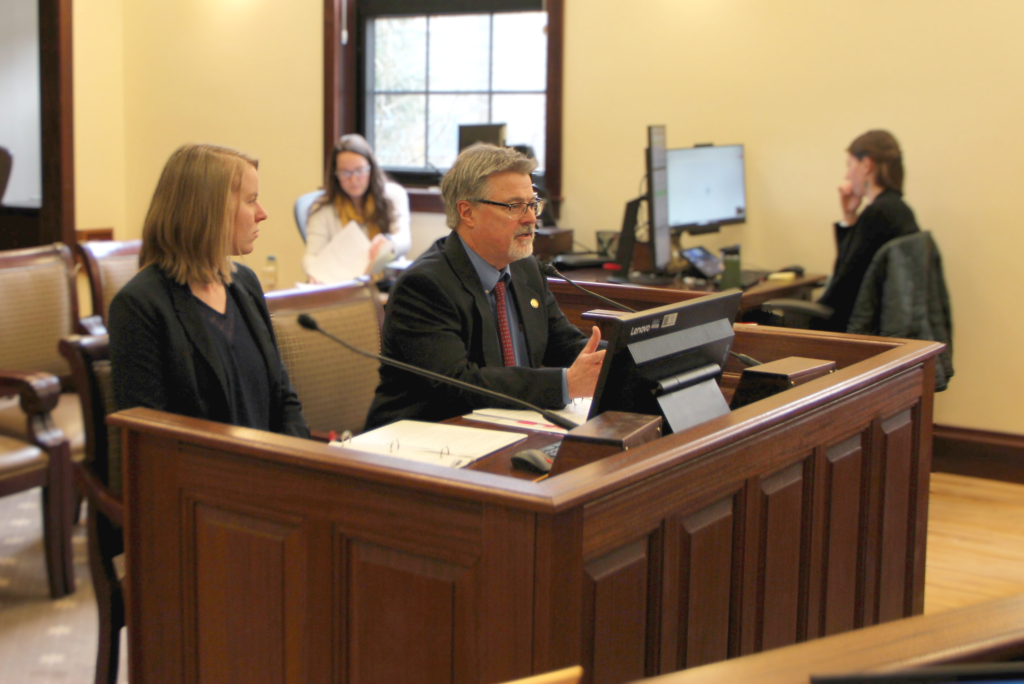
GDP-Based Spending Cap | SB 36 / SJR 4
Senate Bill 36 is a functional state spending cap which constructively links our private sector performance (measured by GDP) and government spending. An effective limit like this one creates stability and predictability in our budgeting process – in economic boom years, extra revenues are pushed forward, preventing the need for drastic cuts in economic bust years. SB 36/SJR 4 is in the Senate Judiciary Committee.
Permanent Fund Account Modernization | SJR 5
A little background, the Permanent Fund is broken into two accounts, the constitutionally un-spendable Principal (~70 billion) and the spendable Earnings Reserve Account (ERA) (~10 billion). In 2018, the Legislature began using a 5 Percent of Market Value (POMV) draw to manage withdraws from the Permanent Fund. That 5% is based on best practices of other large endowment funds. Since then, yearly POMV draws and required inflation proofing have begun depleting the ERA.
There is a growing understanding by both the Permanent Fund Corporation and the Legislature that the two-account structure (where only the ERA is available for appropriation by the Legislature) could result in a fiscal crisis if the ERA is ever depleted far enough. At the end of last year, APFC’s Board of Trustees produced “2024 APFC Trustees’ Paper 10” which outlines in much more detail the problem and recommended solution. You can read that here >>
SJR 5 consolidates the Principal and the Earnings Reserve into one account managed for total return. It then constitutionalizes a “no greater than” 5.5% yearly POMV draw. The expectation is that a lower POMV draw would be put into statute. It also includes language ensuring that a Permanent Fund dividend is paid yearly according to a formula in statute. SJR 5 is currently in the Senate Judiciary Committee.
Creating an Office of Information Technology | SB 38
Senate Bill 38 recognizes the fundamental role of Information Technology (IT) projects in innovative solutions that can move Alaska into a new era of management and operations. This bill establishes the Office of Information Technology within the Department of Administration. This legislation creates clear roles, guides development of structured processes, and standardizes management practices for overseeing IT projects across state agencies.
We empower the State Chief Information Officer (CIO) to oversee IT projects, ensuring adherence to best practices, ensuring budget compliance, and delivering results that align with legislative intent. SB 38 also requires state agencies to document IT project requirements in biennial information technology plans, promoting transparency and accountability. Advancing this bill helps to create a more efficient, responsive, and customer-driven information technology landscape in our state, ensuring that IT projects continue to play a crucial role in enhancing the lives of all Alaskans. SB 38 is currently in the Senate State Affairs Committee.
Creating an Office of Information Technology | SB 38
Senate Bill 38 recognizes the fundamental role of Information Technology (IT) projects in innovative solutions that can move Alaska into a new era of management and operations. This bill establishes the Office of Information Technology within the Department of Administration. This legislation creates clear roles, guides development of structured processes, and standardizes management practices for overseeing IT projects across state agencies.
We empower the State Chief Information Officer (CIO) to oversee IT projects, ensuring adherence to best practices, ensuring budget compliance, and delivering results that align with legislative intent. SB 38 also requires state agencies to document IT project requirements in biennial information technology plans, promoting transparency and accountability. Advancing this bill helps to create a more efficient, responsive, and customer-driven information technology landscape in our state, ensuring that IT projects continue to play a crucial role in enhancing the lives of all Alaskans. SB 38 is currently in the Senate State Affairs Committee.
Volcano Preparedness
There has been news surrounding a possible eruption at Mount Spurr, located 75 miles west of Anchorage. Here is some information and ways to stay informed on this developing situation.
AVO (Alaska Volcano Observatory) designated Mount Spurr at Alert Level YELLOW (ADVISORY) on March 19, 2025. Activity levels are increased, but imminent eruption is not predicted. We are expected to receive additional warnings from various sources before any major incident involving the volcano.
Even though an eruption is not guaranteed, it is important to understand the effects of an eruption and prepare for them. The potential impacts of an eruption include:
Ashfall: Ash is sharp, and is very dangerous to the lungs (especially to younger people and those with underlying respiratory problems). It can easily cause irritation on skin, in eyes, and in our respiratory systems
Disruption to machines: Ash is small and abrasive, leading it to be particularly harmful to fragile parts and machinery. Ashfall is known to affect the following:
Automobiles
Air travel/aviation
Air filtering systems and other infrastructure
Electronics in general
What do I do?
Remain calm and expect a wide variety of scenarios:
Make an emergency plan >>
Make an emergency kit >>
If the volcano erupts:
Try to stay inside until it is deemed safe by local health officials to go outside
Consider wearing protective gear and clothing if going outside is needed: Long sleeved shirts/pants, goggles, and an n95 dust mask
-Seal entry points to your house to prevent ash from getting inside
-Keep Pets indoors as much as possible to reduce health effects of ash inhalation
Stay informed by connecting to these resources:
Sign up for emergency updates from the city by texting ANCHORAGE to 67283 or signing up online.
Other Links:
Alaska Volcano Observatory Mt. Spurr page
I am Here to Help!
As always, I want to hear from you! Whether you have an opinion you would like to express or if you need help with anything government-related, please reach out via email or phone call and I will do the best to assist you.
Reach out!
By Phone: Monday-Friday, 9am to 5pm
By Email: Anytime!
P: 907-465-4949 | E: Sen.James.Kaufman@akleg.gov

